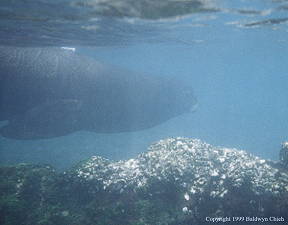
Santiago seen from Santa Cruz

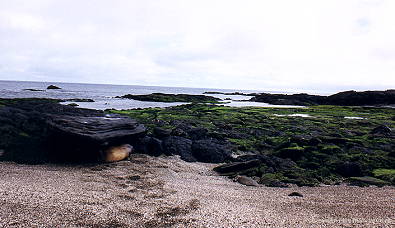
Santiago Island, also known as James Island, is in the central part of the Galápagos, northwest of Santa Cruz, and north of Rabida. We've had phenomenal weather up till now, hot but not overly so, with the sun shining brightly. Today, it is overcast, and as we go on our hike, it rains lightly. Renato insists that this is the cool dry season, and says it's not raining, it's misting. Well, it still feels like rain.
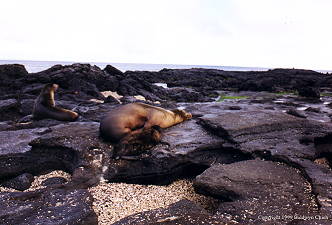
|
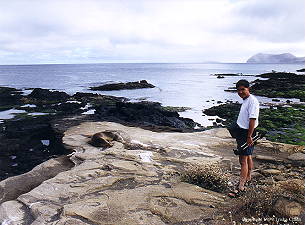
|
To me, Santiago looks alot like Fernandina might in a few hundred thousand years. The coastline shares the same basalt lava fields, but here their jagged edges have been softened over time by erosion. The landscape isn't quite as desolate since soil has covered some of the lava, and vegetation has taken hold.
Puerto Egas, the visitor site where we have a wet landing, is named after the person who in the early 1960's set up a salt factory on this island. A model home for workers sits abandoned, unfinished on a cliff at this landing point. The salt factory was only able to stay in business because of an agreement Se\ñor Egas had with the president of Ecuador at the time. When the new president took office, he quickly realized that there was no reason to pay extra for salt to be transported from the Galápagos when it is just as easy to get it from the mainland.
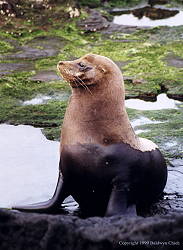 The beachmaster surveys his realm |
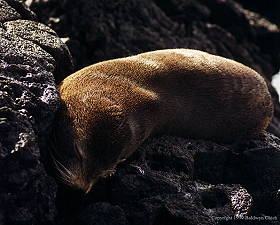 A fur seal naps on a rocky bed |
By now, we aren't surprised to see sea lions, nor are we surprised how accepting they are of our presence. Along the shore, sea lion mothers nursed their newborn pups, while slightly older pups played in the tidal pools. One thing we hadn't really had a good look at until this island, is the fur seal. The fur seal is darker than the sea lions, and smaller as well. Much more timid of man, this seal has been hunted for its soft fur.
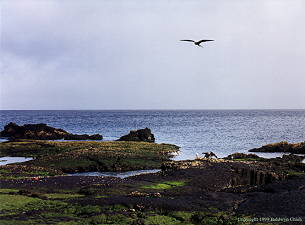 A frigate hovers, waiting to ambush, as a great blue heron and pelicans feed in the tidal pools |
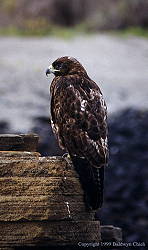 Mature Galápagos hawk |
We search the tidal pools for sea life, and on occasion octopi can be found. We've had rather different desserts after our meals on the boat, and I felt compelled to say, "I wonder if we'll have octopi for dessert today." Mike Spitz seemed particularly injured by that pun, not that I can blame him.
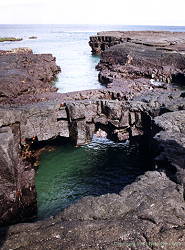 |
Several interesting structures have formed here thanks to the erosion due to the ocean waves. Natural rock bridges hang over the green ocean water. We also found Darwin's Toilet, which fills with sea water then abruptly "flushes" as the waves roll in. I have my doubts that Charles Darwin used this natural portapotty, but I guess he had to sit somewhere to come up with the theory of evolution.

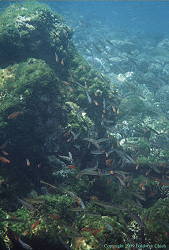
|
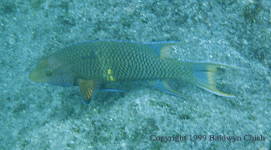
|
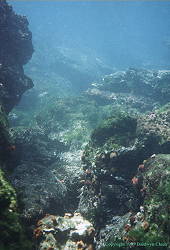
|
The waters are beautifully clear today, and it turns out to be Trisha's day. She sees another white-tipped reef shark, a hornback shark and followed a pacific green sea turtle for a couple of minutes. Intent on trying to see a particular starfish, she looks up to find another sea turtle watching her less than two feet away. They watched each other for at least a minute until the turtle got bored and swam away. A few of us got to watch pelicans diving up close. I surfaced just as one entered the water about six feet away from me. Unfortunately, it wasn't quite clear enough to watch it under water. One of the pelicans stood, wings outstretched for several minutes, as I surfaced near the rock he was standing on. I'm not sure if he was drying his wings, or just posing waiting for his picture to be taken. Meanwhile, the beachmaster patrolled the area, barking noisily, and drawing the cautious attention of all the snorkelers. He passed me a few times, but thankfully for me kept far enough distance.
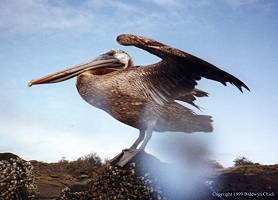
|
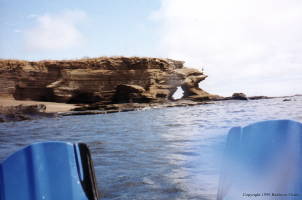
|
